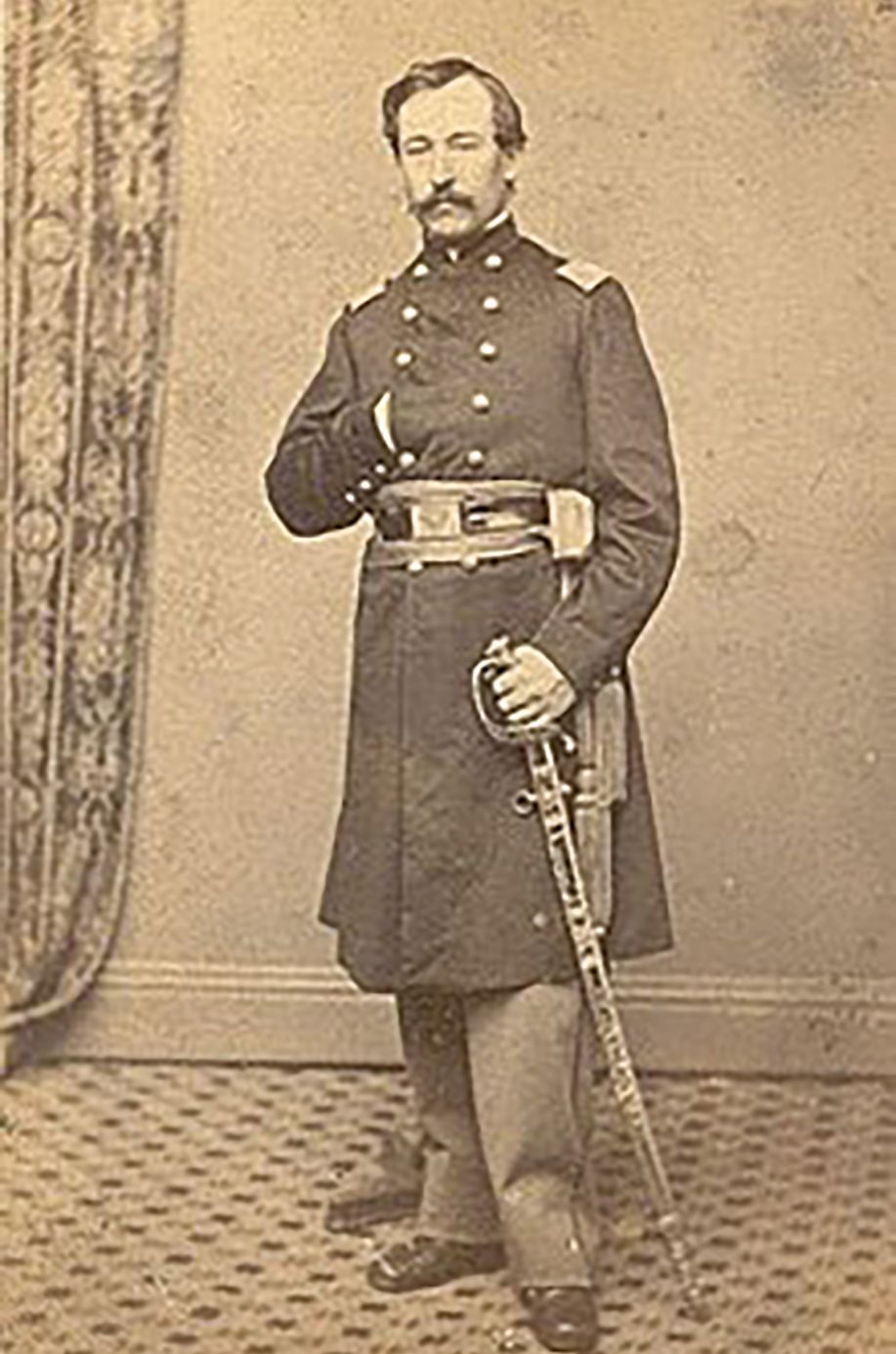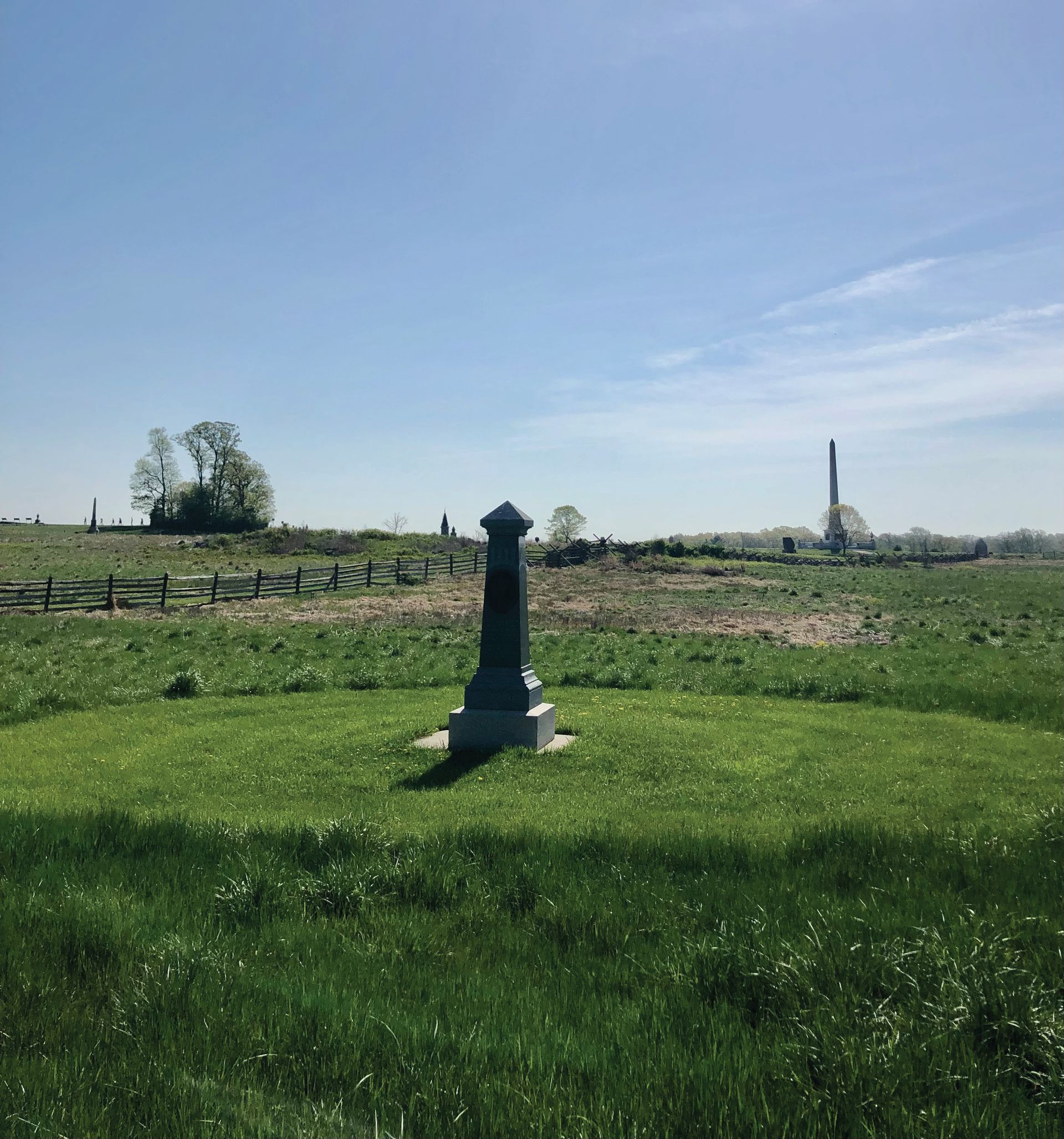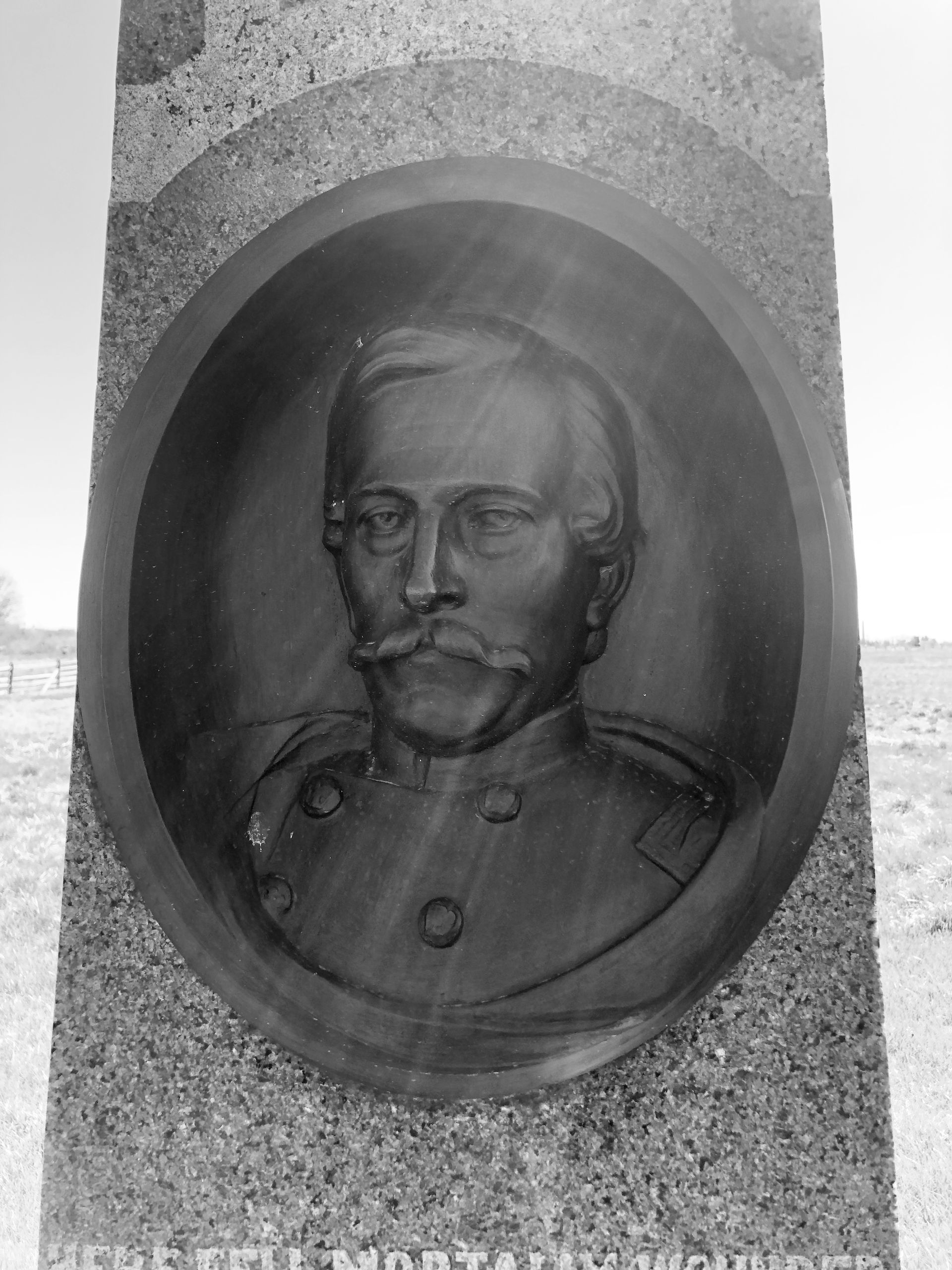A Monument For An Unforgettable Man
by Diana Loski

Colonel George H. Ward
(US Army War College, Carlisle, PA)
The monument is dedicated to the memory of one man’s valor against impossible odds, in the early evening of July 2, 1863. His name was George Hull Ward.
The Union line that day had practically unraveled due to the disobedience of one man, a highly ranked Federal corps commander who disliked General Meade and the position in which Meade had placed a certain body of men.
General Dan Sickles of the Federal Third Corps is one of the main reasons that July 2, 1863 was Gettysburg’s bloodiest day. His disregard for military protocol and direct disobedience to orders from his superior commander caused thousands more Union and Confederate casualties in places where no one should have been fighting.
Sickles moved his corps out from the main Union line on July 2 and placed them – with large gaps in-between his troops – in Devil’s Den, the Wheatfield, and the Peach Orchard. The land was untenable and the large gaps in the line made it easy for the Confederates to outmaneuver the men in blue recently deployed there. As soldiers from other corps raced to help, the entire Union line was placed in jeopardy, including the Federal center on Cemetery Ridge.
Though Sickles survived Gettysburg with his reputation, many more men were not so fortunate. One of them was the courageous Colonel George Ward, the commander of the 15th Massachusetts Infantry at Gettysburg.
George Hull Ward was born in Worcester, Massachusetts, on April 26, 1826, to Artemas and Sarah Ward. He grew up in the middle of a large family of nine children. When Sarah Ward died in 1842, Artemas remarried and six more children were born. George was a machinist by trade, and like his father before him, took an interest in the local militia – a common activity in the early and mid-19th century. He married his sweetheart, Emily Mayo, when he was 25 and well set up in trade. A daughter, Carrie, soon joined the couple, but died at age 2. Two sons, George William and Robert Lincoln Ward were born a few years later and lived to adulthood.1
When war broke out in 1861, it was a natural continuation for the local militia to offer their services, and the Massachusetts men from Worcester were no exception. The 15th Massachusetts mustered on June 12, 1861, one of the earliest regiments to do so. Ward was named the Lieutenant Colonel of the regiment, with Colonel Charles Devens as its commander. In executing a raid, the regiment found itself in a major engagement in what became the Battle of Ball’s Bluff in northern Virginia on October 21, 1861.
The Battle of Ball’s Bluff, in Loudon County, was fought in heavy woods and around steep cliffs along the banks of the Potomac. Colonel Devens had been ordered to conduct a raid in the vicinity, but found no Confederate camp. With faulty intelligence and inexperienced superiors, the 15th Massachusetts, along with multiple troops ferried there by Lincoln’s friend, Senator Edward Baker, found themselves at the mercy of vigilant Confederate forces. After a terrible fight in which the Union was found to be woefully inadequate in a Southern stronghold, over a thousand Federal troops were killed, wounded or missing. Among the killed was Senator Baker. Among the severely wounded was George Hull Ward.2
Lt. Colonel Ward suffered two bullet wounds in his left leg that shattered the bone and rendered saving his leg impossible. His leg was amputated “by the light of two candles.” The recovery was long and slow, and the artificial limb given to him proved practically useless.3

The Ward Memorial, near Cemetery Ridge
(Author photo)
The 15th Massachusetts was part of the Federal Second Corps, commanded by General Winfield S. Hancock, and found themselves in William Harrow’s brigade. Colonel Harrow was experiencing sickness during the march, so Colonel Ward took over command, temporarily, of the brigade. Colonel Ward wrote, “I am all right. I shall fight if I get the chance, that is certain; nothing but my leg will stop me. I can ride anywhere anybody can, but if we are obliged to go where horses cannot, I shall be obliged to stop. I am in for it, and shall take the chances.”4
The chance came in the early evening of July 2, 1863. As part of Gibbon’s Division, Hancock’s Corps, the men of the 15th were deployed on Cemetery Ridge. Their fellow compatriots, the men of the 1st Minnesota, were ordered into the fray farther up the line by General Hancock as he saw Confederates rushing toward the ridge with no one left to defend it – all who were deployed to the left of the center had gone into the nether parts of the field to aid Sickles’s men, who should never have ventured forward in the first place. As fresh troops were on their way from Culp’s Hill to stem the gray tide, the call came for the 15th Massachusetts and their fellow 82nd New York Infantry to enter the fight as Confederates from Wilcox’s and Wright’s brigades rushed to take over the ridge – nearly a day before Pickett’s Division would make the attempt.5
Vastly outnumbered and an easy target on horseback, Ward realized he should not ride. He dismounted with difficulty, and sent back the horse. Soon the 82nd was flanked and began to fall back. Colonel Ward, hoping to save his men, ordered them to retreat, and was simultaneously shot in his right leg. Bleeding profusely, Ward would have remained there but some of his men grabbed him and dragged their commander back to Cemetery Ridge.6
Like the First Minnesota, who suffered enormous casualties to buy ten minutes of time, the 15th Massachusetts and 82nd New York were also sacrificed to help keep the ridge until reinforcements arrived. They were, to that effect, successful.
The terrible event lends credence to why General Lee felt that a concentrated charge by a larger body of troops the following day would likely break the Union center, since he almost carried it by the merest chance the day before.
Before the fated Pickett’s Charge began on July 3, Colonel George H. Ward of the 15th Massachusetts died in a field hospital of his disastrous wound.
He is buried in the Rural Cemetery in Worcester, Massachusetts.7
The 15th Massachusetts fulfilled their three-year service in 1864. They never forgot their intrepid colonel. A few years later, in 1868, the veterans of the 15th raised funds to erect a memorial to Colonel Ward. It is the small monument off the Emmitsburg Road, near the Codori farm. On the site it reads:
Here Fell
Mortally Wounded
July 2, 1863
George H. Ward, Colonel
Commanding 15th Reg’t Mass Vols.
His comrades and fellow citizens of Worcester Raise this Memorial of his Valor and Patriotism.8
The small memorial, precisely situated, is praise indeed.

Bas relief image of Ward on his monument
(Author photo)
Sources: Ancestry.com : George Hull Ward Family Tree. Long, E.B. The Civil War Day by Day: An Almanac 1861-1865 . New York: Doubleday, 1971. Coco, Gregory A. Ed. From Ball’s Bluff to Gettysburg…and Beyond: The Civil War Letters of Private Roland E. Bowen, 15th Massachusetts Infantry, 1861-1864 . Gettysburg: Thomas Publications, 1994. Ford, Andrew E. The Story of the Fifteenth Regiment Massachusetts Volunteer Infantry in the Civil War, 1861-1864 . Clinton: Press of W.J. Coulter, 1898 (copy, Gettysburg National Military Park). The George Hull Ward Memorial, Cemetery Ridge, Gettysburg.
End Notes:
1. Ward Family Tree, Ancestry.com.
2. Long, p. 129.
3. Coco, p. 34.
4. Ford, pp. 250-251.
5. Pfanz, pp. 374-375.
6. Ford, pp. 267-268.
7. Ward Family Tree, Ancestry.com
.
8. The Ward Memorial, Gettysburg.

